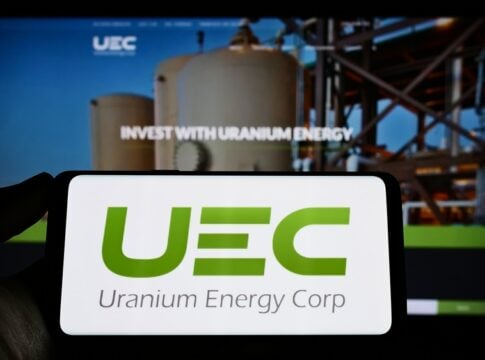The U.S. Environmental Protection Agency (EPA) plans to cancel $7 billion in solar energy grants, according to official sources. These grants were given to states, tribes, and nonprofits through the Solar for All program. This program, made possible by the Inflation Reduction Act (IRA), helps low- and moderate-income families access clean energy. It supports rooftop and community solar installations.
The EPA said it is preparing formal notices to 60 recipients, informing them that their contracts may be revoked. The “Solar for All” program aimed to help solar installations in communities that have been underserved.
Many grant recipients had signed contracts and started their projects when the EPA froze the funds earlier this year. Now, these organizations worry about getting the support they were promised.
The move is part of the Trump administration’s effort to rethink or cancel some climate programs set up during Biden’s presidency. According to officials, the EPA is reviewing whether the “Solar for All” grants were issued in compliance with federal rules. Still, critics warn this change might hurt clean energy growth and access in struggling areas.
Sunset Before Sunrise: Projects Stalled Midway
Before the freeze, the Solar for All program was expected to help install solar systems for up to 900,000 households. The grants aimed to lower electricity bills for families by up to 20%. They also sought to boost energy reliability and create jobs in clean energy.
Some grant recipients, like tribal governments, state energy offices, and local nonprofits, started using the funds. They hired workers, planned construction, and designed outreach programs. These early actions relied on signed contracts, meaning many projects had legal and financial commitments.
With the EPA’s proposed cancellation, these efforts may now be on hold or completely abandoned. Community groups say some residents who signed up for solar panels are unsure about their installation status. Others say job training programs funded by the grants may lose momentum just as they were gaining interest.
Nonprofit legal groups and state attorneys general are looking into legal action to stop the cancellation. Some say that stopping the grants might break the Administrative Procedure Act. They believe this could also mess with the separation of powers in the U.S. Constitution, since the grants were part of an approved federal budget.
Boom Meets Policy Headwinds: Can Solar Keep Rising?
The U.S. solar industry remains one of the fastest-growing parts of the energy sector. In early 2025, the country added 10.8 gigawatts (GW) of new solar capacity—the fourth-highest quarterly total ever recorded.
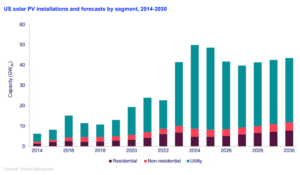
Moreover, solar makes up about two-thirds of all new power generation capacity in the United States. Solar projects are on the rise. California, Texas, and New York are leading in residential, commercial, and utility-scale installations.
However, experts warn that policy reversals like the EPA’s could harm this momentum. Community solar, especially in low-income areas, depends on public funding and federal incentives to thrive. Without grants like Solar for All, many developers may choose not to build projects in these areas due to cost and risk.
A report from the Solar Energy Industries Association (SEIA) found that solar deployment might drop 23% below expected growth by 2030. This could happen if tax credits and clean energy programs are removed.
- This includes the risk of losing up to 54 GW of planned capacity, affecting both grid reliability and job creation.
As demand for electricity rises due to data centers, electric vehicles, and AI, losing clean energy growth may lead to more reliance on fossil fuels.
Equity in the Dark: Who Loses When Solar Stops?
The Solar for All initiative was created not just to promote clean energy, but also to reduce energy poverty. Many of the households targeted by the program pay a large share of their income on electricity.
Solar power can lower bills and also offer backup power during emergencies. Plus, it improves indoor air quality by cutting down on gas appliances.
The program also supported energy justice goals by prioritizing tribal communities, rural areas, and urban neighborhoods most affected by pollution. It aimed to support battery storage, job training centers, and workforce programs. This would focus on areas with high unemployment or limited clean energy projects.
Canceling the program could increase the energy gap. Wealthy communities can afford rooftop solar, but many others cannot. It could also slow down organizations that were finally making progress after years of struggling to fund small clean energy projects.
What Comes Next for Clean Energy Grants?
At the time of this writing, the EPA has not yet finalized the cancellations, but plans to do so in the coming weeks. In the meantime, legal challenges are expected to move through the courts. Some judges have blocked parts of the climate funding freeze. More rulings may decide if the Solar for All grants should be honored.
The U.S. solar industry is still strong. However, changes in federal funding policies may impact where and how quickly future projects happen. Developers might move to larger commercial and utility-scale projects in more profitable areas. This shift could neglect the community solar market, which programs like Solar for All have supported.
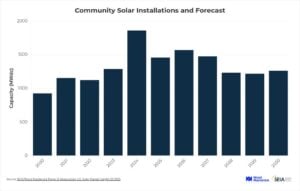
In 2024, the U.S. community solar market added 1.745 GWdc, the largest-ever annual total—a 35% increase over 2023. Growth was led by states like New York, Maine, and Illinois, with New York adding 861 MWdc, up 66% year-over-year.
However, the Q2 2025 SEIA/Wood Mackenzie report predicts a 22% drop in community solar installations for 2025. This decline is due to policy uncertainty and backlog issues. Still, the longer-term outlook is cautious yet hopeful.
Despite the setback, many local groups and clean energy advocates like Powerbank (formerly Solarbank) remain committed to expanding access. They hope funding will come back. If not, they want state incentives or private financing to help fill the gap. Still, the EPA’s decision marks a key moment for federal support of clean energy in low-income communities.
The EPA’s proposed cancellation of $7 billion in solar grants highlights the tension between climate goals and political shifts. While the solar market is growing, policy uncertainty creates risks. This is especially true for low-income households that need government help to access clean energy.
The courts may either allow the grants to move forward or uphold the cancellation. This shows that clean energy success relies heavily on stable policies, clear laws, and long-term commitment.
The post U.S. EPA Plans to Cancel $7 Billion in Solar Grants: What It Means for Solar Industry appeared first on Carbon Credits.
Carbon Footprint
Standard Chartered to Sell 5M Carbon Credits to Help Protect Amazon Rainforest
Standard Chartered has signed a five-year deal to sell up to five million carbon credits on behalf of the Brazilian state of Acre. The major bank and the state are working together to fund rainforest conservation using the carbon credit market.
Credits will be created within a REDD+ framework. This global system aims to cut emissions from deforestation and forest degradation.
Carbon credits will start being issued in 2026. They will be in the “avoided deforestation” category. This means they help prevent emissions by preserving current forests instead of creating new ones. The goal is to prevent deforestation and protect biodiversity and community livelihoods. It also helps reduce greenhouse gas emissions.
The deal could raise as much as $150 million in funding. Acre officials say that 72% of the proceeds will go to local and Indigenous communities. This will help them protect and conserve forests. The rest of the funds will support project management and monitoring systems. This will help ensure transparency and effectiveness.
Why Rainforest Protection Matters in Global Climate Goals
Forests—especially tropical rainforests like the Amazon—are among the most important carbon sinks on the planet. When they’re cut down or degraded, the carbon stored in trees and soil is released into the atmosphere.
The Amazon rainforest absorbs billions of tons of carbon dioxide each year. A NASA-led study found that, in a typical year, the Amazon rainforest absorbs about 2.2 billion metric tons (2 billion tons) of CO2. This is crucial for stabilizing the Earth’s climate.
Experts say that about 20% of global land-use emissions come from deforestation and forest degradation. This makes protecting rainforests one of the quickest and cheapest climate actions today.

Deals like Standard Chartered’s with Acre help banks and businesses support conservation. They can also meet their corporate net-zero goals.
The agreement combines solid financial support with environmental care. It shows how carbon credits can work with climate science and help communities grow.
Standard Chartered’s Chief Sustainability Officer, Marisa Drew, remarked:
“We’re leveraging our global network and carbon market expertise to address this challenge directly, offering a means to help preserve standing forests that act as vital carbon sinks, and in turn help the communities that depend on them continue to realise the economic and social returns they provide.”
High Integrity or Bust: Building Trust in Carbon Offsets
One of the biggest challenges in carbon markets today is credibility. Over the past few years, concerns have emerged about the quality and transparency of carbon offset projects. Some faced criticism for exaggerating emissions cuts. Others did not provide real environmental or social benefits.
To help address this, the Acre–Standard Chartered deal includes safeguards. First, there will be no forward selling of credits—this means credits will only be sold once they are officially issued and verified.
This reduces the risk of overpromising and underdelivering. The transaction also supports adherence to the Core Carbon Principles (CCPs) developed by the Integrity Council for the Voluntary Carbon Market (ICVCM). These principles define standards for top-quality carbon credits and include key factors like:
- permanence,
- additionality,
- leakage, and
- solid monitoring, reporting, and verification (MRV) systems.
The Acre project aims to create a real, measurable impact. Buyers and climate watchdogs want this more than ever.
Beyond the Trees: Inside the Bank’s Broader Climate Finance Strategy
This deal with Acre is part of a bigger move by Standard Chartered to increase its activity in sustainable finance and carbon markets. The bank has supported early-stage carbon removal firms like UNDO. UNDO uses enhanced weathering of rocks to take carbon out of the air.
The financing deal, supported by British Airways, had a unique structure. It included insurance and long-term offtake agreements.
Standard Chartered also partners with Puro.earth, a top carbon removal registry. This gives clients access to high-quality Carbon Dioxide Removal Certificates (CORCs). These types of credits are increasingly in demand from companies that want to go beyond carbon neutrality and achieve net-negative emissions.
The bank plans to achieve net-zero operations by 2025. It will use high-integrity carbon credits to offset emissions from energy use, air travel, and data centers. It also has a 2050 net-zero target for its financed emissions—those generated by the activities of companies it lends to or invests in.

The Carbon Market Is Growing Up – Fast
Standard Chartered’s deal also reflects broader trends in the voluntary carbon market (VCM). According to recent reports, the VCM was valued at around $2 billion in 2024, and could grow significantly in the coming years.

McKinsey & Company projects the VCM could reach over $50 billion by 2030 under favorable policy and corporate demand conditions. With strong market reform, the value could exceed $250 billion by 2050, driven by net-zero goals and increasing regulation.
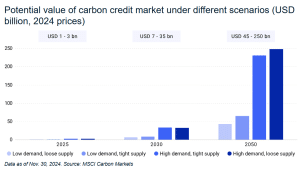
One of the most important shifts is the rise of jurisdictional REDD+ credits—like those offered by Acre. Jurisdictional credits differ from small-scale projects because they cover whole regions or states.
This approach offers wider environmental protection. It also lowers the risk of “leakage.” This is when conservation in one area leads to deforestation moving elsewhere.
Jurisdictional programs are also more attractive to institutional investors and sovereign funds. Large buyers usually want scalability, accountability, and local community benefits. Traditional project-level carbon offsets often fail to meet these needs.
The carbon market is expanding beyond forest protection. It now includes carbon removal technologies like direct air capture, biochar, and mineralization. These solutions are still new, but they are vital for reaching global net-zero goals. This is especially true in tough sectors to decarbonize, like cement, aviation, and steel.
A New Standard for Carbon Finance and COP30
The Standard Chartered–Acre partnership stands out not just for its scale, but for its approach. It focuses on real climate outcomes, community benefits, and market integrity. In doing so, it may serve as a model for future deals between financial institutions, governments, and Indigenous groups.
This is especially important ahead of COP30, the global climate summit set to be hosted in Belém, Brazil, in 2025. As the world focuses on Amazon conservation and climate justice, projects like Acre’s are set to shine. They show how nature-based solutions can achieve financial, environmental, and social goals.
By treating forests not just as carbon stores but as living ecosystems supported by local people, this deal shows that climate action and development do not have to be at odds—they can move forward together.
The post Standard Chartered to Sell 5M Carbon Credits to Help Protect Amazon Rainforest appeared first on Carbon Credits.
Carbon Footprint
UEC Stock Surges as Sweetwater Uranium Project Gets Federal Fast-Track Approval
Uranium Energy Corp (UEC) announced that its Sweetwater Uranium Complex in Wyoming had been officially designated as a transparency project by the U.S. Federal Permitting Improvement Steering Council. This recognition comes under President Trump’s March 20, 2025, Executive Order aimed at accelerating domestic mineral production.
The decision allows Sweetwater to move through a fast-track permitting process, cutting project delays that are critical to national mineral and energy goals. Once upgrades are complete, Sweetwater will be the largest dual-feed uranium facility in the United States.
Significantly, it marks a major step toward restoring domestic uranium production and advancing U.S. energy security.
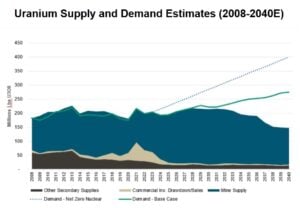
Trump Administration Presidential Appointee, Emily Domenech, Executive Director of the Federal Permitting Improvement Steering Council, highlighted:
“I am excited to welcome the Sweetwater Complex to the FAST-41 transparency dashboard in support of President Trump’s goal of unlocking America’s mineral resources. The uranium that this project can produce would be game-changing for our nation as we work to reduce our reliance on Russia and China, strengthen our national and economic security, and reestablish a robust domestic supply chain of nuclear fuel.”
UEC’s Strategic Acquisition Pays Off
UEC acquired 100% of Rio Tinto’s Wyoming uranium assets, including the fully licensed Sweetwater Plant and 175 million pounds of historic resources. This purchase added eight permitted and exploration-stage projects to UEC’s portfolio, strengthening its hub-and-spoke production platform in Wyoming.
The complex now boasts a licensed production capacity of 4.1 million pounds of U₃O₈ annually, giving UEC a significant position in the U.S. uranium supply chain. The upcoming TRS (Technical Report Summary), expected by the end of fiscal 2025, will formally outline the Great Divide Basin Hub-and-Spoke model, designating Sweetwater as the hub supported by multiple satellite mines.
Amir Adnani, UEC President and CEO, stated:
“Sweetwater’s selection under FAST-41 reinforces its national importance as a key project to achieve the United States’ goals of establishing reliable infrastructure, supporting nuclear fuel independence. Acquired from Rio Tinto in 2024, Sweetwater will be UEC’s third hub-and-spoke production platform, following operational advancements underway in Wyoming’s Powder River Basin and South Texas. On completing this tack-on permitting initiative, Sweetwater will be the largest dual-feed uranium facility in the United States, licensed to process both conventional ore and ISR resin. This will provide the Company unrivaled flexibility to scale production across the Great Divide Basin, leveraging UEC’s leading domestic resource base. We’re proud of and grateful for the Steering Council’s support under President Trump’s Executive Order to fast-track a secure, predictable, and affordable supply of critical minerals.”
Building a Scalable ISR Mining Platform
The company recently revealed that it is working to amend Sweetwater’s permits to include In-Situ Recovery (ISR) mining methods—an environmentally friendly and lower-impact uranium extraction process. The plan includes adding a new ion exchange and elution circuit at the Sweetwater Plant.
The “spokes” in this system will draw resources from:
- Red Desert deposits: REB, ENQ, and Sweetwater
- Green Mountain zones: Round Park, Phase 2, Whiskey Peak, and Desert View
- Other nearby deposits: JAB, Clarkson Hill, and Red Rim
This hub-and-spoke approach is designed to scale production while lowering costs and minimizing environmental disturbance.
Why Sweetwater Matters to U.S. Energy Policy?
The Executive Order that triggered Sweetwater’s fast-track status reflects a broader White House push to rebuild the nuclear fuel supply chain. The U.S. has been increasingly dependent on foreign uranium sources, making domestic production a matter of energy security.
By adding Sweetwater to the FAST-41 transparency dashboard, federal agencies are prioritizing faster reviews, more transparency, and better coordination for critical mineral projects. The Bureau of Land Management will serve as the lead agency for Sweetwater’s permitting process.
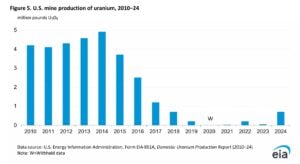
The chart from EIA’s Domestic Uranium Production shows that the U.S. uranium mines produced about 0.6–0.7 million pounds of U₃O₈ in 2024. This big drop over the years has made the U.S. more dependent on imported uranium.
That’s why the government is now pushing to boost local production. UEC’s Sweetwater Uranium Complex is part of that plan. Once upgrades are complete, Sweetwater’s estimate of 4.1 million pounds annually could be enough to cover most of today’s total U.S. uranium output on its own.
America’s Largest Licensed Uranium Complex
The Sweetwater Processing Plant is a 3,000-ton-per-day conventional uranium mill with full licensing and state permits in place. Once ISR methods are approved, Sweetwater will become the largest licensed uranium production facility in the country with dual-feed capability.
Key advantages include:
- Massive Resource Base – Over 175 million pounds of historic uranium resources
- Extensive Exploration Data – 6.1 million feet of historic drilling and ~108,000 acres under control
- Existing Permits – Approval already in place for conventional mining at Sweetwater, Big Eagle, and Jackpot mines
- Cost and Time Efficiency – Upgrading an existing plant is far faster and cheaper than building a new one, leveraging existing infrastructure for synergy and scale
The company also owns a high-grade Canadian project portfolio anchored by the world-class Roughrider deposit- one of the largest physical uranium stockpiles in the United States. In addition, it maintains a significant equity stake in Uranium Royalty Corp. This diversified portfolio would help UEC tap into opportunities from the growing global demand for uranium.
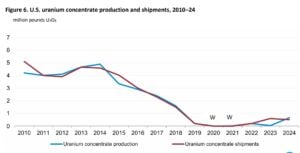
UEC Joins Global Push to Triple Nuclear Power by 2050
Nuclear power has long been the backbone of U.S. carbon-free electricity. According to the World Nuclear Association, in 2022, nuclear accounted for 19% of U.S. electricity generation—and 55% of the country’s carbon-free power. This avoided 482 million metric tons of CO₂ emissions, equivalent to removing about 107 million gasoline cars from the road for a year.
The push for nuclear energy has global momentum. At the COP28 climate summit in 2023, more than 20 nations agreed to triple nuclear capacity by 2050. UEC has pledged support for this international effort.
Green Mining Goals
UEC has committed to producing uranium under the highest environmental standards, aiming for net-zero CO₂ emissions across its U.S. ISR operations and maintaining zero significant environmental incidents annually.
The company’s air quality monitoring program reported no non-compliance in 2023. Radon and uranium particulate emissions were kept well below regulatory limits, with no harmful environmental releases.
This environmental track record supports UEC’s claim that ISR mining can be both commercially viable and environmentally responsible.

UEC Stock Market Momentum
UEC’s strong operational news has translated into equally strong stock performance. Over the past year, the share price has surged by approximately 114%, with gains of 51.8% in the past month and 14.1% in the past week alone.
On August 7, 2025, the stock reached a new 52-week high of $9.91 and is currently trading at around $9.85. Analysts remain bullish, citing sector optimism and positive policy developments, with most price targets above current levels.
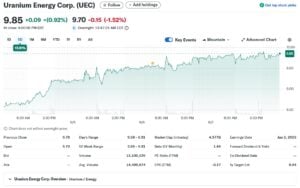
However, they caution that high volatility remains due to the company’s current lack of profitability and its sensitivity to broader market shifts. In short, momentum is strong, but risk is real.
The Bigger Picture: U.S. Uranium Revival
Sweetwater’s fast-track designation signals more than just a win for UEC—it’s part of a national strategy to rebuild America’s nuclear industrial base. By unlocking domestic uranium resources, the U.S. can reduce its reliance on imports and strengthen its clean energy mix.
For UEC, it cements the company’s role as a leading domestic uranium supplier, capable of scaling production rapidly to meet future nuclear energy demand.
The post UEC Stock Surges as Sweetwater Uranium Project Gets Federal Fast-Track Approval appeared first on Carbon Credits.
Carbon Footprint
Lenovo Launches TruScale DaaS for Sustainability to Cut IT Carbon Emissions by 35%
Lenovo launched its TruScale Device-as-a-Service (DaaS) for Sustainability. This subscription service helps businesses cut their IT carbon footprint by up to 35%. It also lowers device costs.
This all-in-one service manages the entire lifecycle of devices, incorporates carbon tracking tools, and offers flexible subscriptions. In doing so, it supports sustainability goals while improving budget efficiency.
The launch shows a bigger change in how companies view technology. It’s not just about tools for getting things done; it is also about helping with corporate climate action.
IT now plays a key role in helping organizations meet their net-zero and ESG (Environmental, Social, and Governance) commitments.
John Stamer, Lenovo’s Vice President and General Manager for Global Product Services, stated:
“Enterprises are rethinking how they manage IT – not just for performance, but for purpose. TruScale DaaS for Sustainability reflects our vision for the future of IT: circular by default, intelligent by design, and accountable by outcome.”
What Is TruScale DaaS and How Does It Work?
TruScale DaaS lets companies subscribe to laptops, desktops, servers, and other IT devices. This way, they can use the equipment without owning it.
Lenovo takes charge of device deployment, maintenance, refurbishment, and safe disposal. This setup cuts e‑waste, reduces the need for new device production, and lowers emissions tied to supply chains.
Key features include:
-
Lifecycle Management:
Devices are refurbished and redeployed, extending their usable life and conserving resources. Lenovo reports that more than 1 million devices have already been recovered and reconditioned under its asset recovery services.
-
Carbon Impact Portal:
Businesses can monitor emissions at each stage—manufacture, use, and disposal—helping them understand where to target reductions. It supports detailed Scope 1, 2, and some Scope 3 tracking for IT equipment.
-
CO₂ Offset Services:
Organizations can offset emissions they cannot avoid, aligning with their science-based targets or internal climate pledges. Lenovo partners with verified third-party carbon offset providers to ensure quality and transparency.
This model supports both ecological stewardship and operational efficiency. By outsourcing the management of IT assets, companies can also free up internal resources to focus on core priorities.
How TruScale Slashes Costs
Traditional IT spending often locks companies into fixed costs for hardware they may underuse. TruScale reduces waste by allowing businesses to adjust subscriptions to meet actual demand. This means no more overspending on unused or old devices.
According to Lenovo, businesses using TruScale can reduce IT maintenance costs by up to 40%. They also benefit from lower downtime due to AI-assisted diagnostics, proactive repairs, and optimized logistics. This boosts workforce productivity while extending the useful life of every device.
The subscription model takes away capital expenses (CapEx). It turns IT spending into operational expenses (OpEx). This flexibility is especially valuable during uncertain economic conditions or rapid business changes.
Environmental Impact: From E‑Waste to Carbon Savings
The core strength of TruScale lies in its environmental benefits, which include:
E‑Waste Reduction
Refurbishing used devices helps the environment. It keeps electronics out of landfills and reduces the need to mine raw materials. This includes lithium, cobalt, and rare earth metals. Mining these materials may harm the environment and raise human rights issues.
Carbon Footprint Reduction
Manufacturing one laptop can produce 200–400 kg of CO₂, depending on the materials and energy mix used. By refurbishing instead of replacing, TruScale avoids these emissions. Lenovo estimates customers can reduce IT-related emissions by up to 35%.
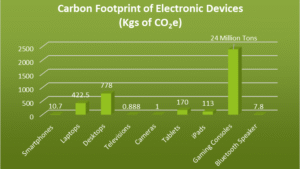
Circular Economy Model
TruScale aligns with global movements to reduce, reuse, and recycle. The circular approach saves energy, cuts pollution, and boosts resource efficiency.
Additionally, Lenovo itself has committed to reducing its own carbon emissions. It also aims for 90% of products to be repairable and recyclable by 2025—further reinforcing the company’s focus on sustainability.
Lenovo’s Journey to Net Zero by 2050
Lenovo is aligning its climate strategy with the Paris Agreement’s 1.5 °C goal. It aims for net-zero greenhouse gas emissions by 2050. The Science Based Targets initiative (SBTi) validated this target in January 2023.
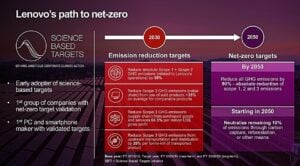
Its near-term goals are to cut Scope 1 and 2 emissions by 50% by 2030. This is based on the 2019 level. They also aim for significant Scope 3 reductions:
- 35% for product use, 66.5% per revenue in purchased goods and services, and 25% per tonne-km in logistics.
Lenovo is boosting its climate efforts with a supplier emissions reduction program. This program affects almost all of its procurement spending. It also features renewable energy pilots. These pilots aim to reduce emissions by about 30,000 metric tons in 2025.
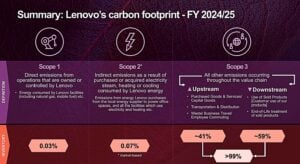
In its 2025 ESG Report, Lenovo highlighted its progress. The company received top honors, including Platinum from EcoVadis and an ‘AAA’ MSCI ESG rating.
Lenovo’s move comes as the carbon credit market gains momentum. By 2024, the voluntary carbon market (VCM) is worth about $2 billion. Analysts believe it could hit $50 billion by 2030. It may go even higher if policy support and corporate demand keep increasing.
TruScale’s carbon offset offerings tap into this trend. Clients can offset emissions from IT hardware. They do this by buying high-quality credits.
Prices for these credits now range between $13 and $15 per metric ton of CO₂, up from $3–5 just a few years ago, as quality and scrutiny have improved.
Lenovo ensures its offset services meet international standards such as Verra’s VCS, Gold Standard, or American Carbon Registry (ACR). This helps companies cut greenwashing risks. It also improves climate disclosures. They follow frameworks like the Task Force on Climate-related Financial Disclosures (TCFD) or CSRD in the EU.
Why Businesses Embrace Sustainable IT Solutions
Across sectors, businesses face rising pressure from investors, regulators, and consumers to clean up their environmental footprint. At the same time, companies need more agile and cost-efficient IT systems to remain competitive in the digital economy.
By offering a bundled solution, TruScale allows firms to hit both targets. Companies can cut emissions and e-waste. They can also follow regulations and report ESG performance. This can all happen while remaining lean and flexible.
According to a recent survey by IDC, over 70% of IT decision-makers say that sustainability will be a key driver of IT purchases within the next five years. Early adopters of sustainable services, like TruScale, can boost their reputation. This is especially true with eco-aware clients and stakeholders.
Why TruScale Is a Climate-Smart Investment
For companies looking to lower costs, meet climate goals, and stay ahead of tech trends, TruScale offers a clear advantage. It does the following:
-
Cuts emissions from IT hardware.
-
Reduces e-waste and material use.
-
Lowers total cost of ownership.
-
Enables better ESG reporting.
-
Increases IT agility and resilience.
In a world where every business is under pressure to prove its climate action, TruScale helps translate sustainability into everyday operations. Lenovo is showing that smart, scalable IT management can also be a powerful tool for environmental leadership.
READ MORE: Schneider Electric Launches AI-Native Initiative for Sustainability and Energy Management
The post Lenovo Launches TruScale DaaS for Sustainability to Cut IT Carbon Emissions by 35% appeared first on Carbon Credits.
-
Climate Change2 years ago
Spanish-language misinformation on renewable energy spreads online, report shows
-
Climate Change Videos2 years ago
The toxic gas flares fuelling Nigeria’s climate change – BBC News
-

 Greenhouse Gases1 year ago
Greenhouse Gases1 year ago嘉宾来稿:满足中国增长的用电需求 光伏加储能“比新建煤电更实惠”
-

 Climate Change1 year ago
Climate Change1 year ago嘉宾来稿:满足中国增长的用电需求 光伏加储能“比新建煤电更实惠”
-

 Carbon Footprint1 year ago
Carbon Footprint1 year agoUS SEC’s Climate Disclosure Rules Spur Renewed Interest in Carbon Credits
-
Climate Change2 years ago
Why airlines are perfect targets for anti-greenwashing legal action
-
Climate Change Videos2 years ago
The toxic gas flares fuelling Nigeria’s climate change – BBC News
-
Climate Change2 years ago
Some firms unaware of England’s new single-use plastic ban



